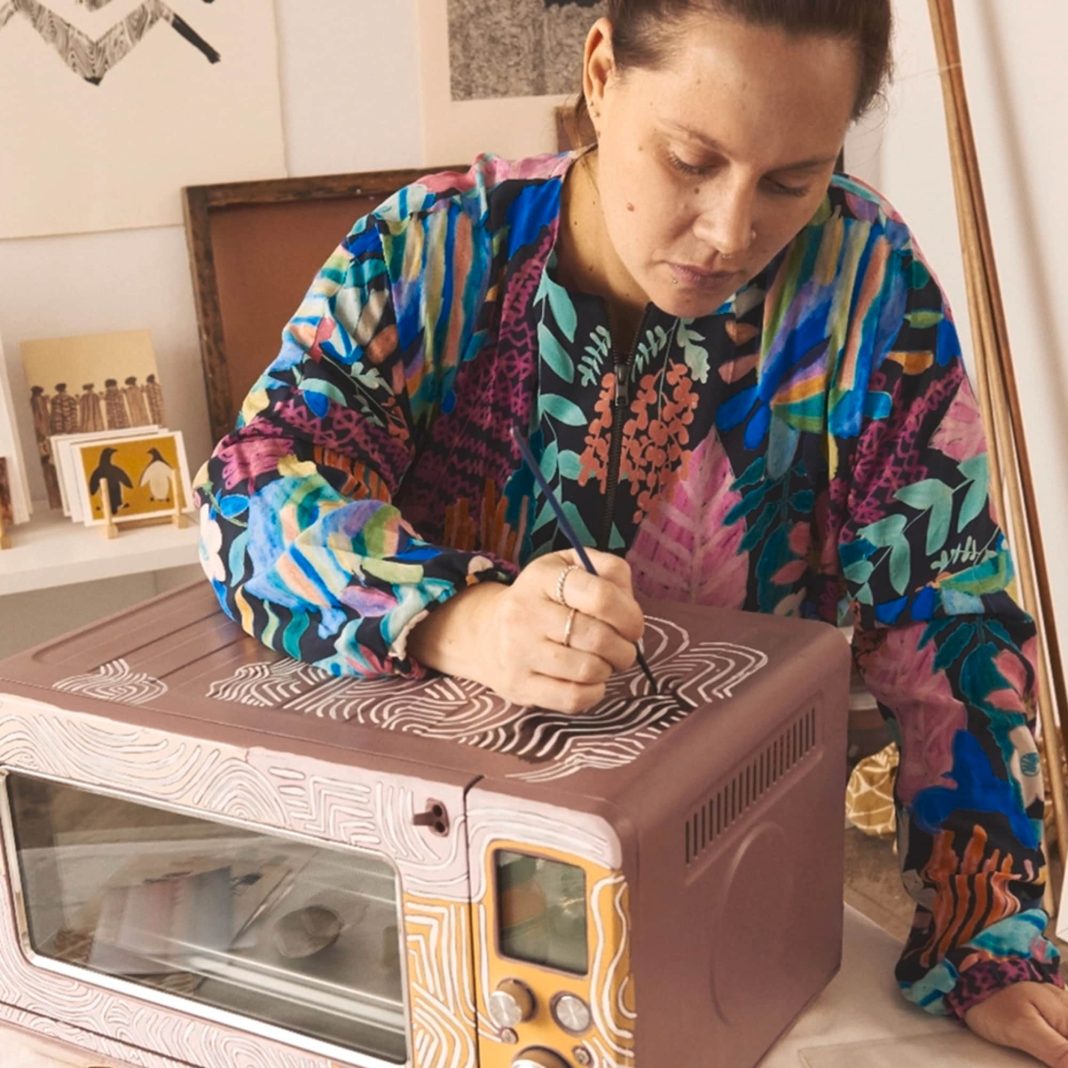Stunning contemporary kitchen objects, wrapped in Country and painted by Aboriginal artists, are on display alongside traditional Indigenous hunting and cooking tools in a new exhibition that opens at the National Museum of Australia today, Friday 27 May.
Heralding an enduring partnership between the National Museum and Australian company Breville, the unique exhibition, An Aboriginal Culinary Journey: Designed for Living, is on display in the Museum’s new Lake View Landing space.
It focusses on the continuity of cultural mark-making associated with Indigenous food culture by pairing First Nations traditional tools for living alongside six modern kitchen objects also richly marked with signs of Country and culture.
The Breville art project was initiated and developed by Alison Page, a Wadi Wadi and Walbanga woman of the Yuin nation, who is on the National Museum’s Indigenous Reference Group and is Adjunct Associate Professor in Design at the University of Technology Sydney and founder of the National Aboriginal Design Agency.
The exhibition displays objects used for food gathering and preparation such as grinding stones, cutting tools (flints), coolamons, firesticks, and baskets associated with Indigenous food culture, alongside the kitchen objects, painted by Western desert artists from Kiwirrkurra: Warlimpirrnga Tjapaltjarri (Pintupi), Yalti Napangati (Pintupi), and Nikua (Yukultji) Napangati (Pintupi) and Sydney-based artist, Lucy Simpson (Yuwaalaraay).
Breville is donating 100 per cent of its profits from the collection to the National Indigenous Culinary Institute of Australia, Indi Kindi by the Moriarty Foundation, and other initiatives supporting the creation of opportunities for Aboriginal and Torres Strait Islander people.
Ms Page said the collaboration celebrates and helps maintain one of the oldest food cultures in the world, combines ancient stories with the best of contemporary design, and brings a little of ‘Country’ into people’s homes.“For generations, Australian Aboriginal people have been gathering around campfires to prepare and cook food. They have used various tools and appliances. These include boomerangs for bringing down game and coolamons for collecting bulbs, grains and small game. Fire sticks were used to light fires for cooking, and containers were made from bark or seaweed (kelp) to carry water, while grinding stones were used to make bread from seeds and to crush berries and other plants,” Ms Page said.
“I wanted to connect these highly sophisticated design objects with the idea that they provide the same service that our ancient ancestors’ campfires, grinding stones and stone-age tools have done over millennia.
“Mark making has been part of Indigenous culture for millennia – story and identity exist as much on the body, as in sand drawings, on rocks, on boomerangs as they do on kitchen appliances of today,” she said.
The head of the National Museum’s Indigenous Knowledges Centre and Senior Indigenous Curator, Margo Ngawa Neale, said “the significance of juxtaposing traditionally marked objects with newly marked objects of today reveals the dynamism of an adaptive culture and fulfils the Museum’s promise to bring our stories alive”.
“Breville is also an Australian story,” Ms Neale said. “Living in the heart of people’s homes these once ordinary appliances, now wrapped in Country, become cultural ambassadors.”
National Museum director, Dr Mathew Trinca welcomed the partnership.
“Partnerships strengthen and broaden the work of the Museum. We are delighted to partner with Breville on An Aboriginal Culinary Journey, a project that shares Australia’s 65,000 years of Indigenous culture in a modern-day context,” Dr Trinca said.
Jim Clayton, CEO of Breville Group, said that “in an increasingly accelerated world, we are all drawn more and more towards stories and traditions that are enduring”.
“As an Australian company, we are proud to share these stories belonging to the world’s oldest living culture, and to weave them together with our own 90-year history of innovation. With every brushstroke in this remarkable collection, Aboriginal artists bring to life a rich library of traditional knowledge that helped them survive major climatic changes over the last 65,000 years and tell the stories of how they sustained themselves through ancient grains, bushfoods, men and women’s rituals and fire,” Mr Clayton said.
Exhibition objects include coolamons associated with gathering grains, seeds, berries; scoops used for digging and carrying foodstuffs; kelp water carriers; stone knives used to prepare meat; fire sticks; grinding stones used to grind grains to make ‘bread’; hunting boomerangs; bark containers used to brew tea; and woven baskets used to carry produce.
The six Breville appliances include a toaster, kettle, coffee machine, juicer, oven and bambino coffee maker.
To ensure the commissioning of this project had the highest cultural and legal integrity, Breville partnered with Dr Terri Janke, a Wuthathi/Meriam woman and an international authority on Indigenous Cultural and Intellectual Property, known for innovating pathways between the non-Indigenous business sector and Indigenous people in business.
An Aboriginal Culinary Journey: Designed for Living is open from 27 May until 7 August 2022 at the National Museum of Australia, Canberra. The exhibition will tour internationally later in 2022.



